
a web page by Don Roberson |
BOWERBIRDS Ptilonorhynchidae |
||
|
||
|
||
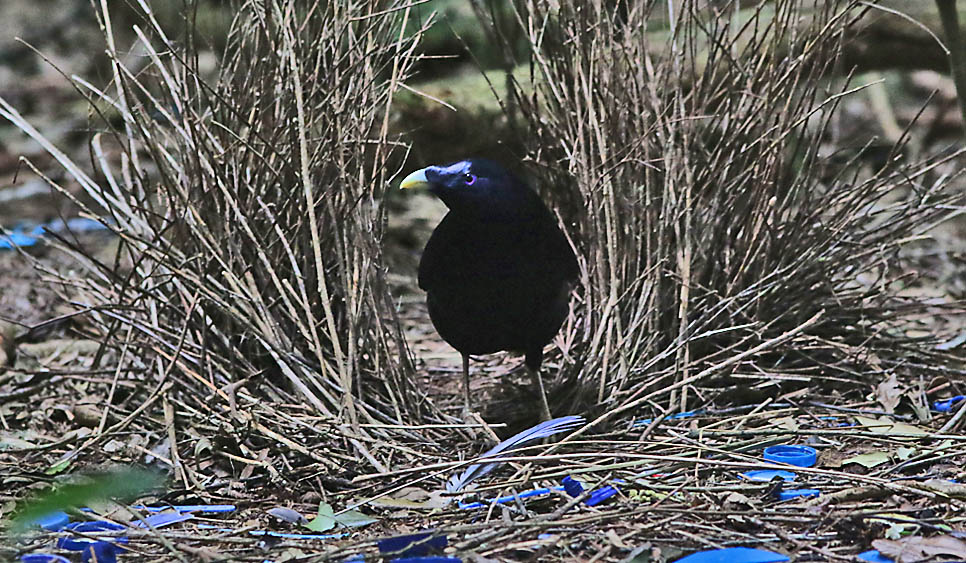 |
||
The male Satin Bowerbird spends most of his life looking after his bowers and the 'treasures' he has brought there. If something bad happens — for example, an Australian Brushturkey walks right across the threshold — he will berate the intruder until it leaves (right), then hop down to discard 'junk' such as a scrubturkey feather mistakenly left there (below left), and then go to work to strengthen the 'avenue' (below right). |
||
|
||
 |
||
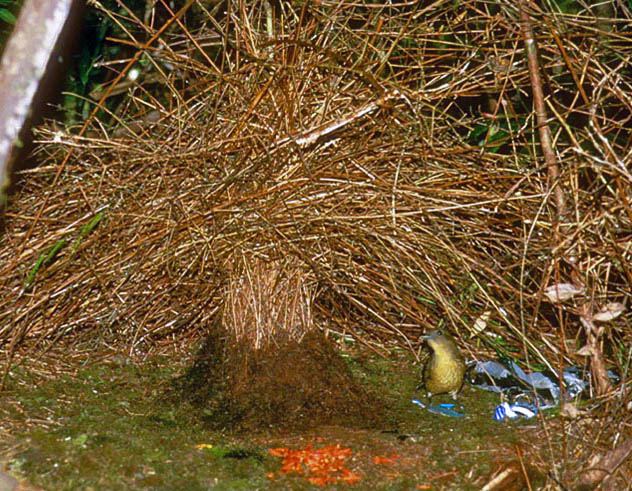 Some
bowerbirds are very plain in plumage. It is these drab males that build
and decorate the most spectacular pieces of architecture in the avian
world. Vogelkop Bowerbird, isolated in the Arfak
Mountains on the Volgelkop Peninsula of western New Guinea, is the
world's greatest bower-builder. Look at the size of this "maypole"
structure (left or above; these are different bowers created by
different males), compared to the size of the bird (he's the size of a
medium-sized thrush). Male Vogelkop Bowerbirds work 9-10 months a year
on his bower in an attempt to attract females to mate. This one (left)
has decorated his bower with green moss, red berries, silver snail
shells, and a bit of decorative film casing and some batteries
accidentally dropped by a National Geographic film team! The male above
laid out rare orange flowers from distance places in the forest on his
green mossy 'lawn.' Given its remote range and exceptionally difficult
access, I'm among very few lucky birders to have watched one of these
working on his art. Some
bowerbirds are very plain in plumage. It is these drab males that build
and decorate the most spectacular pieces of architecture in the avian
world. Vogelkop Bowerbird, isolated in the Arfak
Mountains on the Volgelkop Peninsula of western New Guinea, is the
world's greatest bower-builder. Look at the size of this "maypole"
structure (left or above; these are different bowers created by
different males), compared to the size of the bird (he's the size of a
medium-sized thrush). Male Vogelkop Bowerbirds work 9-10 months a year
on his bower in an attempt to attract females to mate. This one (left)
has decorated his bower with green moss, red berries, silver snail
shells, and a bit of decorative film casing and some batteries
accidentally dropped by a National Geographic film team! The male above
laid out rare orange flowers from distance places in the forest on his
green mossy 'lawn.' Given its remote range and exceptionally difficult
access, I'm among very few lucky birders to have watched one of these
working on his art. |
||
Vogelkop Bowerbird is a member of the "gardener bowerbird" group, which includes the "maypole" building Amblyornis and the "mat" building Archboldia, restricted to high mountains of New Guinea. All are generally plain birds although some have exotic erectible head plumes. The photo (right, by Will Betz) shows a netted MacGregor's Bowerbird high the cloud forests of New Guinea, where it was banded and released. The sometimes concealed orange crown feathers as shown nicely here. Some great photos of a displaying MacGregor's Bowerbird are in Coates (1990). In contrast, spectacular plumages are shown by color-soaked males in some of the "avenue-builders." Perhaps the brightest bowerbird is the bright orange Flame Bowerbird Sericulus aureus of mid-elevations in New Guinea; missing it was one of the bigger disappointments on an otherwise productive trip to Irian Jaya in 1994 [wonderful photos of the male and his bower are in Coates 1990]. |
||
It was once thought that bowerbirds were closely related to the Birds-of-Paradise since both families feature so many spectacular varieties of polygamous males which had evolved in rich food-filled forests in New Guinea and tropical Australia. Biochemical analysis (e.g., Sibley & Ahlquist 1990) showed they are more closely related to the lyrebirds and scrub-birds of Australia, rather than to Birds-of-Paradise which can be thought of as highly modified crows. |
||
Among similarities to the lyrebirds are the vocal abilities of bowerbirds which often include loud calls and skilled mimicry. It is apparent that bowerbirds exist in a wide variety of habitats in Australia and New Guinea. In the hot, dry "red center" of Australia lives Western Bowerbird (male, below). The species builds "avenue" bowers. This male has come to eat fruit at a picnic table. It shows its lilac-colored nuchal crest in this photo, although the crest is not erected here. |
||
 |
||
In contrast, the catbird are birds of the dark interior of humid forests, from lowland jungle to montane cloud forest. This is Arfak Catbird, a recently-split taxa confined to the mountains of the Vogelkop Peninsula (above, in a stunning photo by Tony Palliser). The ten catbirds in genus Ailuroedus do not build bowers and they are monogamous. There are only three "traditional" species: Green Catbird A. crassirostris of eastern Australia, and what were once called "Black-eared Catbird" in NE Australia and New Guinea and "White-eared Catbird" in montane New Guinea. A recent molecular study (Irestedt et al., 2015) split the lowland complex into 3 species and the mid-mountain group into 7 species. Arfak Catbird is among those seven new splits. My own experiences in Australia and New Guinea found that any catbird tended to be shy and hard to see, although their loud cat-like wailings confirmed their presence. The final catbird is Tooth-billed Catbird Scenopoeetes dentirostris, still assigned to a monotypic genus. It is found in upland rainforest in NE Australia and, like all catbirds, is primarily a fruit eater. Males clear and decorate a terrestrial court, and are polygamous. It is gray above and streaked below, and may be an ancient 'bridge' species between the monogamous catbirds and the polygamous bowerbirds. |
||
Photos: The male Regent Bowerbird Sericulus chrysocephalus was at O'Reilly's, Lamington Nat'l Park, Queensland, Australia, on 1 Sep 2016. The male Satin Bowerbird Ptilonorhynchus violaceus and his blue-speckled bower were photographed there that same day. The Great Bowerbird Chlamydera nuchalis was eating fruit in a garden in Mt. Molley town, Queensland, Australia, in Jan 1998, but the bower was on the Mareeba golfcourse, some miles away, and was not actively tenanted during the brief non-breeding season. The Vogelkop Bowerbird Amblyornis inornatus and his bower were photographed from a native-built blind high in the Arfak Mountains above Mokwam, Irian Jaya, New Guinea, on 24 July 1994 (the other bower was in the same general neighborhood). The hand-held male MacGregor's Bowerbird Amblyornis macgregoriae was taken by Will Betz in the 1990s in the Arfak Mts. Murray Lord photograph the male Golden Bowerbird Prionodura newtoniana at Paluma, Queensland, Australia, on 2 Oct 2015. The Western Bowerbird Chlamydera guttata was at Simpson Gap, N.T., Australia, on 16 Aug 2008. Tony Palliser photographed the Arfak Catbird Ailuroedus arfakianus in the Arfak Mts., Papua, Indonesia, in Oct 2016. Uncredited photos © Don Roberson. Credited photos © Murray Lord, Will Betz, and Tony Palliser, as credited, and used with permission; all rights reserved. Family book:
Family book:
Literature cited:
|
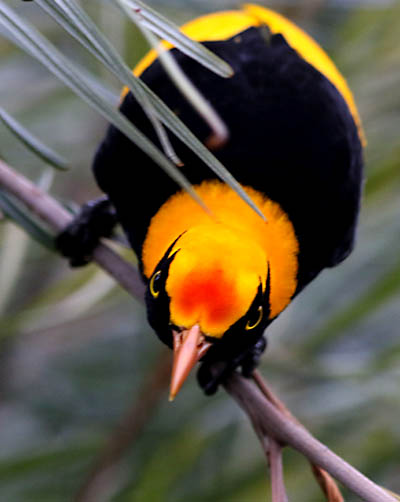 The Bowerbirds are among the most fascinating birds in the world. Some are spectacular, such as the male Regent Bowerbird
(left) of eastern Australia whose colors are shocking in the deep wet
forest. Australia is home to six species of "avenue-builders." These
"avenues" are rows of sticks imbedded in the earth between a narrow
passageway. Colorful objects are placed at either end to attract
females to and then into the gallery. Many males "paint" the inside
walls with plant juice to add color. Representatives are Satin Bowerbird (male in his bower. large photo below) and Great Bowerbird
(male just below, left, and his bower, just below, right). Satin
Bowerbird prefers humid climes and just loves the color blue (even a
blue bottle-cap or toothbrush!) while Great Bowerbird lives in the dry
rain-shadow west of the Atherton tablelands and prefers white and
orange.
The Bowerbirds are among the most fascinating birds in the world. Some are spectacular, such as the male Regent Bowerbird
(left) of eastern Australia whose colors are shocking in the deep wet
forest. Australia is home to six species of "avenue-builders." These
"avenues" are rows of sticks imbedded in the earth between a narrow
passageway. Colorful objects are placed at either end to attract
females to and then into the gallery. Many males "paint" the inside
walls with plant juice to add color. Representatives are Satin Bowerbird (male in his bower. large photo below) and Great Bowerbird
(male just below, left, and his bower, just below, right). Satin
Bowerbird prefers humid climes and just loves the color blue (even a
blue bottle-cap or toothbrush!) while Great Bowerbird lives in the dry
rain-shadow west of the Atherton tablelands and prefers white and
orange.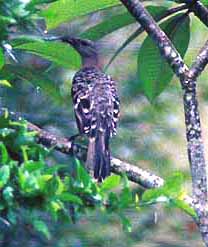
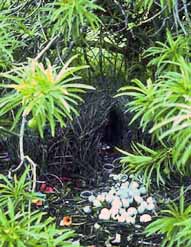



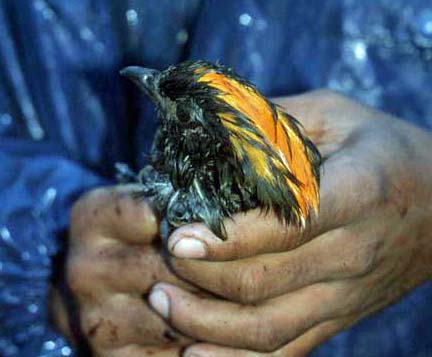
 Northeast Australia has another species with lovely plumage: Golden Bowerbird
(left in a fine shot by Murray Lord). The male builds a "double
maypole" and is an odd offshoot of the Papuan "gardeners." Males build
these bowers to attract and mate with as many females as they can. They
spent 9-10 months of the year constantly working on, improving, and
rearranging their creations — or stealing jewels from nearby bowers.
Northeast Australia has another species with lovely plumage: Golden Bowerbird
(left in a fine shot by Murray Lord). The male builds a "double
maypole" and is an odd offshoot of the Papuan "gardeners." Males build
these bowers to attract and mate with as many females as they can. They
spent 9-10 months of the year constantly working on, improving, and
rearranging their creations — or stealing jewels from nearby bowers. 
